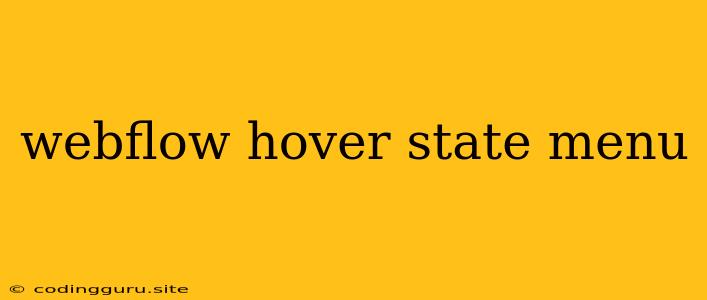Elevate Your Webflow Website with Interactive Hover States for Menus
A website's menu is often the first point of contact for visitors, acting as a gateway to your content. A well-designed menu not only helps users navigate easily but also enhances the overall user experience. One way to achieve this is by implementing hover states on your Webflow menu items.
Hover states allow you to dynamically change the appearance of menu items when the user's cursor hovers over them. This can be a subtle effect or a more dramatic transformation, depending on your design preferences and the desired impact. By adding hover states, you can make your website more engaging, intuitive, and visually appealing.
Why Use Hover States for Your Webflow Menu?
1. Enhanced User Experience: Hover states provide visual feedback to users, indicating that their actions are being registered. This helps guide them through the menu and encourages them to explore further.
2. Improved Navigation: By adding visual cues to menu items, you make it easier for users to locate and select the desired option.
3. Visual Appeal: Hover states can add a touch of dynamism and personality to your website, making it more engaging and visually appealing.
4. Branding Consistency: Hover states can be used to reinforce your brand identity by incorporating your brand colors, fonts, and visual elements.
How to Create Hover States for Your Webflow Menu
1. Start with a Basic Menu: Begin by creating your menu in Webflow. Make sure you have the desired layout and structure in place.
2. Add Interaction Styles: In the Design panel, select the menu item you want to add hover states to. Go to the Interactions tab and click on the + icon to add a new interaction.
3. Choose the Trigger: Select Hover as the trigger. This will activate the interaction when the user hovers over the menu item.
4. Select the Element to Modify: Choose the element you want to affect. This could be the text, background color, or any other element within the menu item.
5. Apply the Effect: In the Action section, choose the desired effect. This could include changing the color, adding a shadow, or animating the element.
6. Customize the Timing: You can adjust the Ease and Duration settings to control how smoothly the hover state transition occurs.
7. Preview Your Menu: Test your hover state effects by previewing your Webflow project in the browser. Adjust the settings as needed until you achieve the desired result.
Tips for Creating Effective Hover States
1. Keep it Simple: Overly complex hover states can be distracting and confusing for users. Focus on creating subtle and impactful effects.
2. Maintain Consistency: Ensure that your hover states are consistent across all menu items to maintain a harmonious visual experience.
3. Consider Accessibility: Ensure that your hover states are accessible to users with disabilities. Avoid using only color changes, as this can be problematic for users with color blindness.
4. Experiment with Different Effects: Explore different hover state effects, such as color changes, background animations, and subtle text transformations, to find the ones that best suit your website's aesthetic.
Examples of Hover State Effects
- Color Change: Change the background color of the menu item on hover.
- Background Animation: Add a subtle animation, such as a gentle glow or a slight ripple effect, to the background.
- Text Transformation: Bold or italicize the text within the menu item on hover.
- Icon Appearance: Change the icon associated with the menu item on hover.
- Shadow Effect: Add a subtle shadow to the menu item when hovered.
Conclusion
By incorporating hover states into your Webflow menu, you can create a more interactive, engaging, and visually appealing website. Experiment with different effects and techniques to find the best approach for your specific design and brand identity. Remember to keep accessibility in mind and strive for a consistent and user-friendly experience. With a little effort, you can transform your Webflow menu from a basic navigation element to a dynamic and captivating feature.
